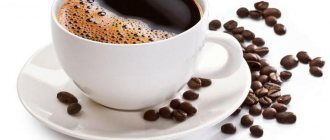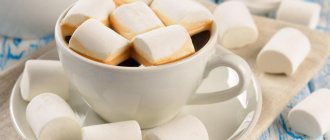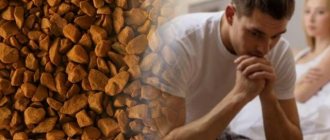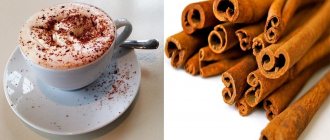Most people are sure that coffee increases blood pressure. This is not entirely true. The effect of the drink can be very different. From stimulating to soporific, from lowering blood pressure to increasing.
Let's try to understand the effect of natural coffee, and not drinks with its addition, like “coffee with chicory.” Also, we are not interested in three-in-one coffee surrogates, decaffeinated coffee and other drinks that have nothing to do with coffee.
Let's try to find out how real coffee, bean (ground) and instant, affects a person, whether it increases blood pressure or not. And if it lowers, then why are most people confident in the opposite?
How much caffeine is in a cup of coffee?
Let's start with what everyone knows. The stimulating effect of coffee is due to the caffeine it contains. But how much caffeine can be contained in one cup of the invigorating elixir?
It turns out that the matter is not only how much powder you take for preparation, but also the caffeine content in it. Moreover, if 100% of what is contained in the spoon gets into the drink from instant coffee, then when brewing ground coffee, not all of the stimulating substance will end up in the cup.
Grinding and even brewing method matter. But on average, a cup can contain from 40 to 60 mg of caffeine. Instant coffee has a slightly larger tonic component, from 60 to 100 mg.
This is explained simply. When preparing a granular extract from grains, the taste and aroma almost completely disappear. And manufacturers do not need to add expensive and aromatic, but less strong Arabica.
Preference is given to cheap Robusta, which has a much higher caffeine content. And to obtain ground coffee, they take a mixture of two varieties. One gives the drink strength, the second – aroma. In general, the strength of the drink is noticeably lower.
What does the number 60 mg mean? For comparison, a Citramon tablet for headaches contains half as much caffeine as a cup of aromatic coffee. And in soluble form – three times more than in a tablet!
Use for hypotension
Blood pressure can also be chronically low - this is hypotension, which occurs less frequently than hypertension, which is standard for the modern sedentary population, but often enough to be mentioned separately.
With low blood pressure, doctors give recommendations that are exactly the opposite of those given for hypertension, which is logical.
Among these recommendations are references to caffeinated foods and drinks. Drinking coffee with chronically low blood pressure is not only allowed, but even recommended. The main thing for the patient is not to confuse high blood pressure with low blood pressure, based only on their feelings.
Main symptoms:
- pale skin;
- weakness;
- decreased performance, intellectual abilities;
- unnaturally rapid fatigue;
- pain in the heart area;
- dizziness, sometimes nausea.
As you can see, some symptoms overlap. In order not to mistakenly assess your condition and ultimately take harmful measures, you need accurate knowledge of your blood pressure norm, as well as a working device for measuring pressure (tonometer).
How does caffeine affect blood pressure?
Some people feel great after the second cup, but after the third they begin to feel sleepy. But for most, the second cup will already be excessive.
You shouldn't drink coffee in one gulp, you need to savor it in sips. Then the enjoyment of the aroma will last longer, and you won’t be able to drink a second cup.
How does coffee affect people with different blood pressure? Doctors do not keep statistics on the effect of coffee on those who currently have high blood pressure. This is understandable; a normal doctor is unlikely to offer such a person a cup of drink with a high caffeine content.
But coffee lovers and self-experimenters, far from medicine, conducted a similar experiment. There were only 12 participants, and therefore serious conclusions cannot be drawn from the results.
So, out of 12 people, only two had increased blood pressure after drinking a GLASS of natural coffee. One is a young girl, 22 years old. Before coffee, the pressure was 90 over 60. After coffee - 102 over 70.
By the way, her example proved that even with frequent consumption of coffee, the effect may not decrease. The second was almost 60 years old. Before drinking coffee, his blood pressure was elevated. And from the numbers 132 to 78 it rose to 140 to 82. Although sometimes there are statements that supposedly with high blood pressure coffee does not increase it, but it turns out that this is not true either.
Among the remaining participants in the experiment, four blood pressure decreased from slightly elevated to normal. One remained elevated. For three it was normal and did not change. Two of them had slightly decreased normal blood pressure. Result: out of 12 participants in the experiment, it decreased in six, in two it increased, and in four it did not change.
This experience allowed us to draw the following conclusions:
Coffee can both increase and decrease blood pressure. Whether blood pressure will increase after ONE cup of coffee depends neither on what it was before coffee, nor on gender, nor on age. This is an individual reaction of each organism.
Irkutsk City Clinical Hospital No. 9
Facts about hypertension:
According to the results of epidemiological studies in our country, about 30 million people (25 - 30% of the population) suffer from arterial hypertension.
- People with high blood pressure are 3-4 times more likely to develop coronary heart disease and 7 times more likely to develop cerebrovascular accidents. In 68 out of 100 cases of myocardial infarction and in 75 out of 100 cases of stroke, patients had long-term elevated blood pressure.
- It has been proven that lowering blood pressure
- even by 3 mmHg. can reduce mortality from stroke by 8%, from coronary heart disease - by 3%.
Arterial hypertension to persistently elevated blood pressure (BP). This is one of the most common diseases.
The only way to know that you have arterial hypertension is to measure your blood pressure!
A level below 130/85 mmHg is accepted as normal blood pressure. Blood pressure between 130/85 and 139/89 is considered elevated and normal.
The diagnosis of arterial hypertension is made when blood pressure is detected above 140/90 mmHg. at least twice during repeated visits to the doctor.
Today there are three degrees of hypertension
| Degrees AG | Systolic blood pressure | Diastolic blood pressure |
| 1 | 140-159 | 90-99 |
| 2 | 160-179 | 100-109 |
| 3 | more than 180 | More than 110 |
There are no symptoms specific to arterial hypertension, but you may suspect this disease if you have:
| If these signs are present |
- attacks of “lightness”;
- dizziness;
- weakness;
- headaches, pain in the heart area;
| Measure blood pressure regularly 3-4 times a day and when symptoms appear and record the results in a diary. |
- noise in ears;
- deterioration of performance and memory;
- flashing “spots” before the eyes, double vision;
- difficulty speaking;
- numbness of the limbs;
- shortness of breath caused by exercise;
- swelling of the legs;
- visual impairment.
Regardless of whether your blood pressure is normal or elevated, be sure to check whether you have risk factors for hypertension and try to reduce their impact on your health:
| Risk factors | Results after risk factor adjustment |
| Excess body weight | A decrease in body weight by 10 kg leads to a decrease in blood pressure by at least 10 mmHg. |
| Physical inactivity | It has been established that regular physical training reduces systolic and diastolic blood pressure by 5-10 mmHg. |
| Chronic stress | With reduced exposure and elimination of stress factors, as well as rest, blood pressure decreases spontaneously. |
| Smoking | Quitting smoking helps reduce blood pressure, cholesterol, fibrinogen in the blood and platelet aggregation activity. |
| Alcohol | Reducing the frequency and dose of a single alcohol intake to 20-30 g of pure ethanol per day for men (200-250 ml of dry wine, 500-600 ml of beer) and 10-20 g for women will avoid the development of hypertension in 11% of men and in 1% of women and reduce the risk of stroke in patients with hypertension by 3-4 times. |
| Excess salt intake | Reducing the consumption of table salt to 4.5 g per day contributes to a significant reduction in blood pressure. |
| Poor nutrition | It has been established that a decrease in systolic and diastolic blood pressure in the population while following the DASH diet leads to a reduction in the incidence of coronary pathology by 15% and strokes by 27%. |
| Coffee | You should not overuse coffee, as drinking 2-3 cups of coffee can increase systolic blood pressure by 3-14 mmHg, and diastolic blood pressure by 4-13 mmHg. |
| You need to measure blood pressure: -at least 2 times a year, if the last time diastolic blood pressure was <85, systolic blood pressure <140 mmHg. -weekly, if the last time diastolic blood pressure was 85-89 mmHg. -daily if systolic blood pressure was >140 and diastolic blood pressure >89 mmHg, especially in the early morning hours from waking up to noon. |
| How to measure blood pressure correctly: 1) one hour before measuring blood pressure, you should not drink coffee or tea, and half an hour before you should not smoke; 2) blood pressure is measured at rest after a 5-minute rest; 3) the hand should be at the level of the heart; 4) clothing should not squeeze the hand; 5) the cuff is placed on the shoulder, its lower edge should be 2 cm above the elbow, the phonendoscope is installed on the brachial artery; 6) pump air into the cuff until the pulsation stops and add another 30 mmHg, then release the air at a speed of approximately 2-3 mmHg. in 1 second; 7) the appearance of pulsation will indicate the figures of systolic blood pressure, the cessation will indicate diastolic blood pressure. 9) if the shoulder circumference is more than 33 cm, it is necessary to use a wider cuff, otherwise the blood pressure numbers will be overestimated. |
Dietary recommendations for prevention and control
Diet for hypertension (DASH)
| Product groups | Number of servings per day | Portion volume | Product names | Practical significance |
| Grain and grain products | 7-8 | 1 slice of bread, 80g dry ground grain, 120ml boiled rice, oatmeal, corn flakes, etc. | Wheat bread, pita, oatmeal, rolled oats | Main source of energy and fiber |
| Vegetables | 4-5 | 160g raw leafy vegetables, 160g cooked vegetables, 180ml vegetable juice | Tomatoes, potatoes, carrots, peas, pumpkin, broccoli, turnips, cabbage, spinach, Jerusalem artichoke, beans | Foods fortified with potassium, magnesium and fiber |
| Fruits | 4-5 | 180ml fruit juice 40g dried fruit 80g fresh, frozen or canned fruit 1 medium sized fruit | Apricots, bananas, dates, grapes, oranges, orange juice, mangoes, melons, watermelons, peaches, pineapples, plums, raisins, strawberries, tangerines | Important sources of potassium, magnesium and fiber |
| Dairy | 2-3 | 240ml milk, 120ml yogurt, 45g cheese | Skim or 1% milk, skim or reduced fat butter, yogurt, cheese | Greatest sources of calcium and proteins |
| Meat, poultry, fish | no more than 2 | 84g cooked meat, poultry or fish | Choose only lean meats, remove visible fat, bake and poach meats instead of frying; remove the skin from the bird | Foods fortified with protein and magnesium |
| Nuts, seeds, beans | 4-5 per week | 42g nuts, 14g seeds, 80g cooked beans | Almonds, hazelnuts, peanuts, walnuts, beans, lentils | Rich sources of energy, magnesium, potassium and fiber |
The diet is based on eating approximately 2,000 calories per day.
Diet . It is advisable to eat food at least 4-5 times a day, distributing it according to the calorie content of the daily diet approximately as follows: breakfast before work - 30%, second breakfast - 20%, lunch - 40%. dinner - 10%. The last meal should be at least 2-3 hours before bedtime.
| YOUR ENEMIES | YOUR FRIENDS |
| Refined foods such as white bread, rice, pasta. | Cereal derivatives - bran bread, black rice, bran, oat flakes, wheat germ, muesli, barley, buckwheat. |
| Snack food - potato and cheese chips, buttered popcorn. | Nuts, almonds, fruits: apricots, bananas, oranges, grapefruit, pears, puffed popcorn. |
| Roasted vegetables, seafood, poultry. | Baked, steamed vegetables, seafood, poultry. |
| Vegetables in rich sauce, oil. | Vegetables with low-fat sauce, seafood with herbs and low-fat or low-fat cheese. |
| Milk, cheese and whole milk ice cream | Reduced fat milk, yogurt. |
| Large portions of fatty meat, sausages, sausages. | Medium portions of lean meat, meat with vegetables. |
| Pasta with cream and cheese sauce. | Pasta with tomato sauce, olive oil. |
| Pizza with fatty cheese, meat, sausage. | Pizza with vegetables, mushrooms, spinach. |
| Hamburgers, cheeseburgers, fried chicken. | Grilled chicken, baked potatoes. |
| Salads with cream sauce. | Salads with olive and corn oil. |
| Coffee, tea, lemonade, Pepsi-Cola, Coca-Cola. | Vegetable and fruit juices, nectars. |
Physical activity for the prevention of arterial hypertension
Aerobic exercise is indicated because:
- large muscle groups take part in them;
- can be carried out for a long time;
- walking, jogging, swimming, tennis, cycling, rhythmic gymnastics contribute to more intense absorption of oxygen by the body and are beneficial for the heart and blood vessels.
Aerobic physical activity ensures maximum oxygen delivery to organs and tissues, so they must be performed at a certain heart rate, which is calculated individually for each person.
| The easiest way to calculate your training heart rate: Maximum heart rate (HR) = 220 - age (years). The training heart rate should be 50% (lower limit) - 75% (upper limit) of the individual maximum heart rate. This formula is valid for relatively “healthy” people. |
- physical activity should be performed at least 4 days a week;
- The duration of physical activity should be 30-45 minutes per day.
| Anaerobic exercises (weightlifting, bodybuilding, which provide high physical activity for a short time) — for high blood pressure CONTRAINDICATED! |
In case of a sharp increase in blood pressure (hypertensive crisis), it is necessary:
- calm down and ensure a comfortable position;
- unfasten the buttons of your outerwear and open the window;
- restore breathing: take a deep breath, hold your breath and exhale slowly, repeat this several times;
- put mustard plasters on calves;
| A drug | Initial dose | Repeat dose | Tactics |
| CLOPHELINE | 0.15 mg (1 tablet) | 0.075 mg | If after 20-30 minutes the pressure does not decrease by 25% of the initial figures, then you need to take the medicine again. If 20-30 minutes after taking the pills again, the pressure has not decreased, CALL A DOCTOR. |
| CAPOTEN | 25 mg (1 tablet) | 25 mg | |
| ATENOLOL | 50 mg (1 tablet) | 50 mg | |
| NIFEDIPINE | 20 mg (1 tablet) | 20 mg | |
| NITROGLYCERINE | 0.5 mg (1 tablet) | — | |
| FUROSEMIDE | 40 mg (1 tablet) | — |
- take the tablet under the tongue (chew or dissolve), taking one of the following medicines from the first aid kit:
| Shiatsu massage techniques are also used to reduce blood pressure. In this case, a soothing method of influencing massage points is used, i.e. continuous, smooth pressure with a gradual increase in pressure over 3-5 minutes. The massage points are shown in the figure. |
Share
What should you drink coffee with?
There is one secret how to drink coffee so that your blood pressure does not increase. It turns out that if you drink coffee with milk or cream, not from powdered milk, but natural, then almost no one’s blood pressure will rise!
Of course, there are those who feel dizzy after just a few sips of coffee. For the rest, with normal blood pressure, you can safely drink a cup of coffee with milk, cream or ice cream.
The fact is that the presence of animal fats in the drink does not allow caffeine to be quickly absorbed into the blood. Therefore, its level does not increase so much. In addition, there is a little less coffee - for the volume that is occupied by milk additives in the cup.
Some believe that adding a slice of lemon to your cup reduces the dangerous effects of coffee on blood pressure. Unfortunately, lemon won't help. Although this wonderful citrus by itself really lowers blood pressure, when paired with caffeine it has the opposite effect.
The belief that coffee should be brewed with cinnamon is also not confirmed in practice. That is, if you replace part of the coffee with cinnamon powder, then in fact there will be no increase in pressure. But if you put as much of the main component as always, nothing will change.
A special case is coffee with alcohol. Increases blood pressure in almost everyone. But a healthy person can afford to drink coffee with cognac or a glass of coffee liqueur.
But you won’t be able to cheer yourself up with coffee after drinking alcohol. At best, you will get a headache. A little coffee in alcohol or a little alcohol in coffee is one thing, but a cup of coffee after a glass of strong drink is already dangerous.
What does pressure mean - tonometer values
When measuring pressure with a tonometer, a person receives two numerical values. More of them indicates the force with which the heart muscle pumps blood into the bloodstream. Normally, this figure should be from 120 to 135 units.
A lower value on the tonometer indicates the strength of blood movement through the human system at the moment the heart muscle relaxes, that is, at the moment when it does not push blood, but is preparing for the next push. Normally, the so-called lower pressure varies from 75 mm Hg to 90 mm.
In addition, it is important to consider the difference between lower and upper pressure. This indicator should tend to 40. That is, a value of 120/80 mm, when the lower indicator is 40 points less than the upper one, is the norm. If the lower one rises to 90 units, and the upper one drops to 115, serious problems with well-being begin.
Why caffeine can lower blood pressure
Let's get back to the good stuff. What explains why coffee can lower blood pressure? It turns out there are several reasons for this. Caffeine can dilate blood vessels. They expand, blood circulates more freely, and tension subsides, and with it pressure.
In very small doses, caffeine acts as an anti-spasm agent. That is, for most people, half a glass of coffee is enough to get rid of a headache, and often reduce blood pressure. Among other things, coffee has a diuretic effect, which also lowers blood pressure.
Symptoms of high blood pressure
High blood pressure never goes unnoticed by a person. As soon as it begins to grow, the following symptoms appear:
- headaches localized in the back of the head;
- tinnitus;
- nausea;
- dyspnea;
- dizziness;
- purple complexion.
A short-term increase in blood pressure can occur due to stress or as a result of another psychological shock. In other cases, an increase in tonometer values is a reason for a comprehensive examination. Hypertension most often develops gradually. This manifests itself as fatigue and poor health, as well as sleep disturbances. It is important to measure blood pressure during headaches in order to notice its increase in time.
Is caffeine a drug? Or not
A person's addiction to coffee is sometimes compared to drug addiction. Of course, this is incorrect. A person who is accustomed to smoking tobacco feels very bad without cigarettes. Irritability and headache appear. A coffee drinker will simply be less energetic. Drowsiness and general weakness may appear in the late afternoon. And in the morning and during the day, if you got enough sleep at night, everything will be fine.
Another thing is that those who are used to drinking coffee constantly begin to increase the frequency of consumption. Sometimes during the working day - four cups, plus in the morning before work. This is already a dangerous habit.
After all, the brain of such a person works under pressure all day. And even those who have low blood pressure and really feel better after drinking coffee should not drink more than two cups a day. The fact is that coffee removes calcium from the body. Frequent consumption of coffee leads to depletion of not only the nervous system, but also the musculoskeletal system.
And in conclusion, I would like to remind you that, in addition to various drinks, the body needs ordinary clean water. And it cannot be replaced by any drinks, even very healthy ones.
Reducing blood pressure without the use of medications
First of all, you need to remember that the first attack of a pressure surge is a reason to purchase a home blood pressure monitor. If signs of hypertension appear, and there are no drugs that can normalize the condition, to relieve the symptoms you need to do the following:
- Provide rest to the body by taking a semi-sitting position.
- Get rid of tight and suffocating clothes (unbutton your shirt, take off your scarf).
- Move closer to a source of fresh air - open a window/turn on the air conditioner.
- Disturb the patient as little as possible with worries and exclamations about his terrible appearance caused by an attack of hypertension.
- Drink green tea or a hibiscus drink made from hibiscus flowers.
- Avoid eating salty foods, as salt, by retaining water in the body, leads to edema and increased blood pressure.
- If after 15 minutes it does not get better, call an ambulance.
You can help relieve the condition by applying wet, cold towels to your forehead.
Contraindications for coffee
At what pressure you drink coffee depends on the general well-being of the person. Its use can both increase and decrease blood pressure, and much depends on the characteristics of the human body. If a person is prone to hypertension, it is not recommended to abuse strong espresso, as this can lead to a stroke or heart attack.
The question of whether it is possible to drink coffee with high blood pressure has already been discussed quite a lot. Experts answer this question with a clear “no.” Many people mistakenly believe that instant drinks or tea have a much gentler effect on the body. Coffee made from natural beans is much easier for a person to tolerate when blood pressure levels fluctuate.
Caffeine and blood pressure are two related concepts. Strong espresso is not allowed to be consumed if the blood pressure is 130/85. If it is very high, then it is better to give preference to juice, green tea or compote.
It is strictly forbidden to consume Arabica if there is an increase in intracranial or ocular pressure. Most often, the cause of this condition is a spasm of the blood vessels in the brain, and caffeine only makes them even stronger. The result of this is a disruption of blood circulation and deterioration in human health.
Does green coffee raise or lower blood pressure?
It is important to know at what pressure you usually drink coffee without harm to your health. In medical practice, its various green varieties are used, which help improve metabolic processes in the body and restore blood sugar levels. However, such grains must be used sparingly so as not to cause harm to the body.
Drinking several cups of green drink can reduce the risk of developing several times:
- oncological diseases;
- diabetes mellitus;
- excess weight;
- capillary pathologies.
The green drink contains caffeine, so it is recommended for healthy people without hypertension or hypotension. If a person is prone to low blood pressure, it can have the following effects on the body:
- the functioning of the cardiovascular system improves;
- the blood circulation process is enhanced;
- brain vessels are stabilized;
- coronary vessels are restored;
- the functioning of individual parts of the brain improves.
Green coffee is not recommended for people with grades 2 and 3 hypertension. For other people it does not pose a danger, but with increasing dosage it can cause spasms of the vascular system and disruptions in the body.
Does coffee increase blood pressure?
The main component of coffee is caffeine, which has a stimulating effect. Whether coffee increases blood pressure depends on certain conditions:
- The drink stimulates the central nervous system, so it is often recommended to drink it when overtired and lack of sleep, as well as to improve brain activity. A high concentration of the substance in the blood causes vascular spasms, which increases blood pressure.
- Caffeine can block adenosine synthesis, which stimulates brain activity but increases blood pressure. It increases the production of adrenaline by the adrenal glands, which is accompanied by an increase in blood pressure.
- As the number of cups you drink increases, the risk of negative consequences increases. As a result, daily consumption of the drink in large quantities leads to the development of hypertension in completely healthy people.
Coffee to increase blood pressure is a potent drink, when consumed, various changes occur in the body:
- after entering the body, caffeine affects the brain and central nervous system, transferring them into the excitation phase from the calm phase;
- acting on the adrenal glands, the production of stress hormones increases;
- the heartbeat quickens and the body falls into real panic;
- blood flow increases, the result of all these complex processes is an increase in pressure.











